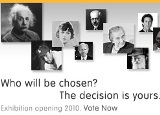 A new museum quickly taking shape not far from the Liberty Bell in Philadelphia will chronicle the experience of Jews in the United States from their first arrival by ship in 1654 to the present day. Multimedia displays and some 20,000 cultural artifacts will focus on telling their story in the context of the freedom America has offered and the rich diversity of the Jewish community itself, said Jonathan Sarna, chief historian of the National Museum of American Jewish History.
A new museum quickly taking shape not far from the Liberty Bell in Philadelphia will chronicle the experience of Jews in the United States from their first arrival by ship in 1654 to the present day. Multimedia displays and some 20,000 cultural artifacts will focus on telling their story in the context of the freedom America has offered and the rich diversity of the Jewish community itself, said Jonathan Sarna, chief historian of the National Museum of American Jewish History.
While exhibits will focus mainly on the Jewish community, he added, “I think any immigrant group, any minority group, will find moments that resonate for them.”
The museum is allowing the public to vote on which 18 Jews from six different fields of activities will be featured in a multimedia presentation. In an unusual move for a museum, it is allowing the public to vote for three candidates in each category, including religion, business, entertainment, politics, sports and more. A total of 218 candidates are offered for consideration, and write-in votes also are allowed.
The 18 displays will be on a rotational basis, with another 18 to replace the first set after a period of time.
According to the museum’s Web site, it is the only one in the nation dedicated exclusively to collecting, preserving and interpreting artifacts pertaining to the American Jewish experience. The museum will seek to educate visitors about how Jews used the opportunities of freedom in America to contribute to society, while also recording the experiences of other ethnic groups.
“Most importantly,” the Web site says, “the coming generations will have a better understanding about who they are and where they came from.”
That idea of the Jewish community’s diverse contributions to American life is underlined in a documentary film on the project shown at the Archives event by Gwen Goodman, former executive director of the museum, who is overseeing completion of the $150 million building.
The film showed Jewish Americans from Supreme Court justices Louis Brandeis and Ruth Bader Ginsburg to author Norman Mailer, poet Emma Lazarus, astronomer Carl Sagan, baseball players Hank Greenberg and Sandy Koufax, composers George Gershwin and Leonard Bernstein, polio vaccine developer Dr. Jonas Salk, and others.
But while the museum will present an inspirational message, Sarna said, “It’s not going to be a presentation of American Jewish life through rose-colored glasses.” Exhibits also will document the discrimination that Jews faced into the first half of the 20th century, restricting them from entering certain professions, universities and clubs.
“One cannot tell the story of the period … without telling the story of social anti-Semitism, of limitations on freedom, and I think our visitors need to know that,” the historian said. “I want young people going to the museum who don’t think twice about applying to different colleges or considering different careers … to know that their grandparents did not have that luxury. And unless they know that, we haven’t done our job.”
Nor will the museum shy away from showing unsavory elements in the Jewish community itself, Sarna added.
“I think a mature community can show its gangsters and the moments that it’s not so proud of even as it trumpets ‘Only in America’ successes. If the museum succeeds … [it will be] because it does both of these things well,” he said.
Museum architect Robert Young described the building’s downtown Philadelphia location, near Independence Hall, the Liberty Bell and other landmarks of the United States’ birth, as ideal. Sarna agreed, adding that “at the time of the American Revolution, Philadelphia really was the center of the American Jewish community.”
{Noam Amdurski-matzav.com Newscenter/America.gov}












What’s the website?